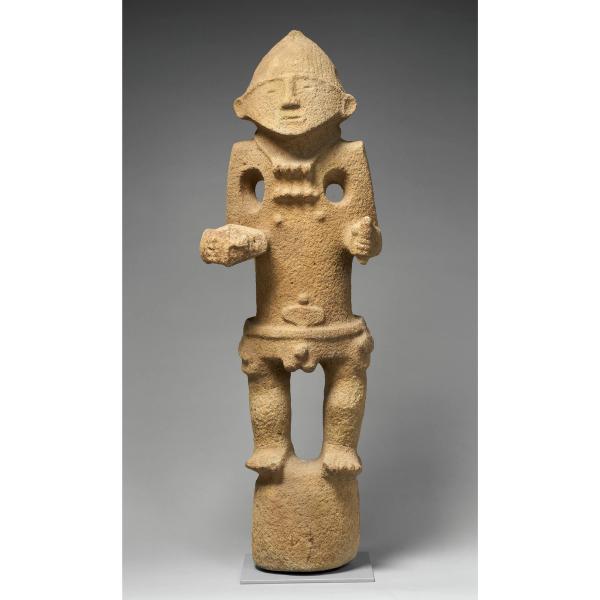Warrior
Further Reading
Hoopes, John. “Magical Substances in the Land Between the Seas: Luxury Arts in Northern South America and Central America,” in Golden Kingdoms: Luxury Arts in the Ancient Americas, Joanne Pillsbury, Timothy Potts, and Kim N. Richter, eds. (Los Angeles: The J. Paul Getty Museum, 2017), pp. 54-65.
Pillsbury, Joanne, Timothy Potts, and Kim N. Richter, eds. Golden Kingdoms: Luxury Arts in the Ancient Americas. Los Angeles: J. Paul Getty Museum, 2017. See especially cat. no. 103, p. 195.
Quintanilla, Ifigenia. “Una escultura de la Gran Chiriquí en Nueva York y su confusa identidad.” Drama de las Esferas. https://ifigeniaquintanilla.com/2013/05/24/una-escultura-de-la-gran -chiriqui-en-nueva-york-y-su-confusa-identidad.
Artwork Details
- Title: Warrior
- Artist: Chiriquí artist(s)
- Date: 300–800 CE
- Geography: Costa Rica
- Culture: Chiriquí, Aguas Buenas Phase
- Medium: Volcanic stone
- Dimensions: H. 36 in. × W. 11 1/2 in. × D. 9 5/16 in. (91.4 × 29.2 × 23.6 cm)
- Classification: Stone-Sculpture
- Credit Line: The Michael C. Rockefeller Memorial Collection, Bequest of Nelson A. Rockefeller, 1979
- Object Number: 1979.206.422
- Curatorial Department: The Michael C. Rockefeller Wing
Audio

1613. Warrior, Chiriquí artist(s)
Orlando Hernández Ying
ORLANDO HERNÁNDEZ YING: This is a typical representation of a military leader holding elements that evidence his military prowess and his virility as well. One is a decapitated head from his adversaries and he's probably holding an axe or some weapon that is actually part of the military regalia that he's wearing.
JOSÉ MARÍA YAZPIK (NARRATOR): Items such as the head of a vanquished enemy or representation of an animal were thought to confer those beings’ attributes onto the leader. For art historian Orlando Hernández Ying, details in this depiction of a Costa Rican Chiriquí warrior signal both local and regional power.
ORLANDO HERNÁNDEZ YING: The conical hat links him to the cultures of West of Panama and a pendant of curly-tailed animals that could be found in Colombia, Costa Rica or Panama…
We can see how these pendants were used by military leaders as part of the display of their authority and their prowess, not only to their own people, but also to possible adversaries.
JOSÉ MARÍA YAZPIK: Although green stones like jade were prized in Costa Rica at the time this sculpture was made, the curly-tailed animal pendant adorning this stone figure is similar to gold ornaments worn by elites in neighboring regions. The depiction of this item suggests that the leader shown here had the authority to summon a golden object from far away.
ORLANDO HERNÁNDEZ YING: What really strikes me as wonderful and interesting is the local context of it and the creativity and singularity of the pieces that were developed in Panama, that we're still discovering and getting reacquainted with in a bigger context. And then we see the similarities of some of the forms and how they connect and how gold traveled from the upper region of South America into the Isthmus of Panama and further on to Costa Rica and as well some of those forms also traveled into the Caribbean.
Listen to more about this artwork
More Artwork
Research Resources
The Met provides unparalleled resources for research and welcomes an international community of students and scholars. The Met's Open Access API is where creators and researchers can connect to the The Met collection. Open Access data and public domain images are available for unrestricted commercial and noncommercial use without permission or fee.
To request images under copyright and other restrictions, please use this Image Request form.
Feedback
We continue to research and examine historical and cultural context for objects in The Met collection. If you have comments or questions about this object record, please contact us using the form below. The Museum looks forward to receiving your comments.